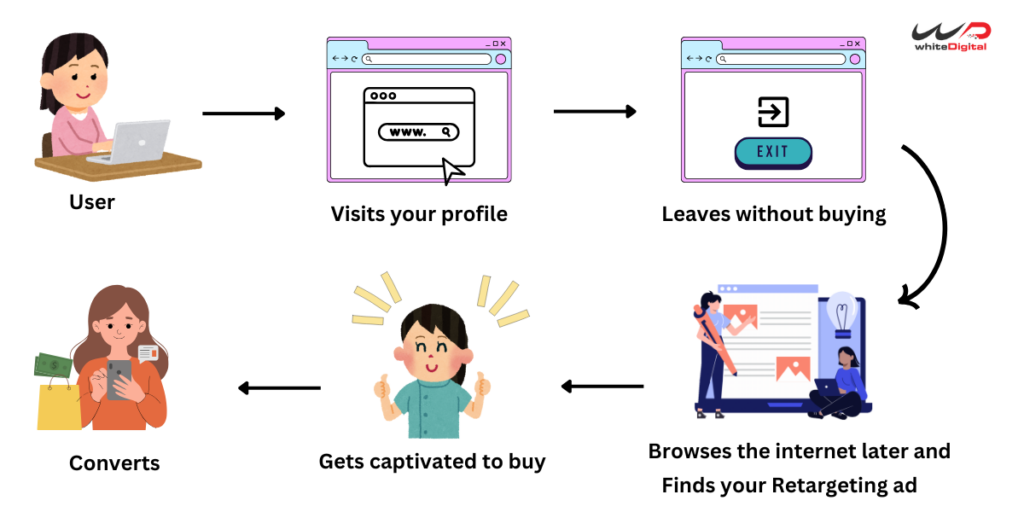Do you know that 63% of online shoppers click on Google Ads before they purchase? The ecommerce world has a huge potential and leveraging Google Ads is crucial for driving traffic and increasing sales.
In this guide we’ll take an in-depth look at understanding the importance of Google Ads for your online store, showcasing the benefits it offers for boosting online sales.
Table of Content
- Brand Awareness to boost sales
- Crafting Effective Ad Creatives
- Optimizing Your Campaigns
- Leveraging Automated Tools
- Retargeting or Remarketing
- Refining Targeting Options
- Making Data-Driven Adjustments
- Competitors’ website ad target
- Advanced Strategies for E-commerce Success
- Placing ads on YouTube
- Discounts and offers in shopping ads to boost your sales
It doesn’t matter whether you’re aiming to attract new customers or maximize your return on investment, this guide is designed to help you make the most of Google Ads. Let’s get started on transforming your online sales strategy with actionable insights and practical tips.
1. Brand Awareness To Boost Sales
Brand awareness plays a crucial role in boosting sales through Google Ads, especially for businesses aiming to establish a long-term presence in the market. While direct conversions are the primary goal for many advertisers, increasing brand visibility is the first step in converting potential customers.

- Google Ads offers several campaign types, such as Display Ads and Video Ads, that are specifically designed to increase brand awareness by showing your ads to a broad audience.
- By targeting the right audience with compelling visuals and messaging, you can create a lasting impression, even if they don’t immediately make a purchase.
- This sustained exposure helps build trust and familiarity with your brand, which is essential when potential customers are ready to buy.
- The key to successfully using Google Ads for brand awareness is strategic targeting. For businesses aiming to reach new customers, Google Display Network (GDN) allows you to place ads on websites across the internet that align with your target audience’s interests and behaviors.
- YouTube Ads provide an excellent platform for showcasing your brand through engaging video content.
- Using Google’s audience targeting options, such as affinity audiences and in-market segments, enables you to show your brand to users who are most likely to be interested, even if they aren’t actively searching for your products yet.
- By presenting your ads to users who fit your ideal customer profile, you increase the likelihood of being remembered when they are ready to make a purchase.
2. Crafting Effective Ad Creatives
Crafting ad copy that captures attention and drives action is essential for a successful Google Ads campaign. Start by understanding your target audience’s needs and pain points. Use clear and concise language that speaks directly to them. Highlight the unique selling points (USPs) of your products or services, such as benefits or special offers.
Incorporate strong calls-to-action (CTAs) that encourage users to take the next step, like “Shop Now” or “Get Started Today.” Make sure your ad copy aligns with the keywords you’re targeting and resonates with your audience’s search intent.
Designing Attractive Visuals and Images
High-quality, relevant images are key to attracting clicks and conversions. Use clear, professional visuals, including lifestyle images to build an emotional connection. Ensure your design, color schemes and banners reflect your brand identity and stand out in ads.
3. Optimizing Your Campaigns
To ensure your Google Ads campaigns continue to perform well, regular audits are essential. Start by reviewing your campaign performance metrics, such as click-through rates (CTR), conversion rates and return on ad spend (ROAS). Identify underperforming keywords, ads and ad groups and make necessary adjustments.
Update your ad copy and visuals to keep them fresh and relevant. Test different bidding strategies and ad formats to see what works best. Continuously monitor and refine your targeting options to ensure you’re reaching the right audience.
Optimizing Product Feeds for Shopping Ads
Optimize your product feeds with accurate, up-to-date data, including titles, descriptions, images and prices. Use high-quality images and relevant keywords for better visibility. Organize categories logically and regularly update to reflect inventory, pricing and promotions.
4. Leveraging Google Automated Tools
Take advantage of Google’s automated tools to enhance your campaign performance. Smart Bidding uses machine learning to optimize bids for conversions or conversion value, helping you achieve your specific goals.
Ad Extensions provide additional information and increase the visibility of your ads, making them more appealing to potential customers. Use automated rules to schedule changes to your campaigns based on specific conditions, such as adjusting bids during peak shopping times.
These tools can save time and improve the efficiency of your campaigns.
5. Retargeting or Remarketing

Retargeting, or remarketing, has become one of the most powerful strategies in a digital marketer’s arsenal. For advanced users, it’s not just about showing the same ads to users who’ve visited your website; it’s about precision targeting, behavioral segmentation and leveraging data to create personalized, dynamic ad experiences that drive high-value conversions. Here is how expert marketers can take retargeting to the next level with Google Ads.
Advanced Audience Segmentation and Customization
Dynamic Remarketing Segmentation: One of the key differences between basic and advanced retargeting is the ability to segment audiences with high granularity. Instead of simply targeting users who visited any page, break down audiences based on actions.
Page Viewers: Differentiate between users who viewed category pages vs. individual product pages.
Cart Abandoners: Target users who abandoned their cart but interacted with a specific product or variant, allowing for tailored messaging around that specific item.
Cross-Sell & Upsell: For existing customers, create audiences based on their purchase history and use remarketing to offer related products or premium versions of what they have already bought.
Engaged Visitors: Target users who visited key pages but didn’t make a purchase, such as those who read reviews or spent more time on product pages.
Cross-Channel Retargeting Integration
Google Search + Remarketing (RLSA): Combine retargeting with Remarketing Lists for Search Ads (RLSA).
For users who have interacted with your website but didn’t convert, bid higher on relevant search queries when they show up again in Google search results.
Tailoring your keywords to capture those “next-step” queries that show stronger purchase intent.
GDN (Google Display Network) + YouTube: Google Display Network (GDN) and YouTube offer extensive reach and high-quality placements for retargeting campaigns.
Expert marketers can use these platforms to deliver remarketing ads with rich multimedia content. For example, show video ads to users who viewed a specific product but didn’t complete the purchase.
Social media + Google Ads: Integrate Google Ads with platforms like Facebook and Instagram by setting up consistent retargeting across channels.
Many experts use Google Ads scripts to synchronize audience lists with Facebook’s audience manager for a holistic multi-channel approach.
6. Refining Targeting Options
Effective targeting is key to reaching the right audience. Use location targeting to focus on specific geographic areas where your products are most likely to sell. Demographic targeting allows you to reach users based on age, gender, household income and other factors.
Interest targeting helps you connect with users who have shown interest in topics related to your products. Combine these targeting options with remarketing strategies to re-engage users who have previously interacted with your site or ads.
Continuously analyze and adjust your targeting settings to maximize your campaign’s impact.
7. Making Data-Driven Adjustments
- Revise Underperforming Elements: Identify underperforming keywords, ads, or ad groups and make necessary changes. This might involve revising ad copy, updating visuals, or changing keywords.
- Test Variations: Experiment with different ad creatives, targeting options and bidding strategies to find the most effective combinations. Use A/B testing to identify what works best.
8. Competitors’ website ad target
To gain a competitive edge in digital advertising, it’s essential to know your competitors and thoroughly analyze their ad targeting strategies.
Understanding Your Competitors’ Ad Targeting
By researching your competitors’ websites and their online campaigns, you can gather valuable insights into who they are targeting, what kind of messaging they are using, and how they structure their ads.

This includes looking at their use of keywords, ad creatives, landing pages, and promotional offers. Understanding these elements helps you identify gaps or areas where you can surpass them in terms of targeting, positioning, or creative execution.
By carefully observing their targeting strategies, you can identify which audience segments they are prioritizing and whether they are focusing on a broad market or narrowing their focus to highly specific groups. This insight helps you fine-tune your ad targeting to better reach those same or similar customer groups.
Identifying Audience Segments and Targeting Strategies
Once you have analyzed your competitors’ strategies, the next step is to target their audience. This can be done by reaching users who have previously visited your competitor’s website or interacted with their ads.
You can also target similar audience segments by using keywords or interests that align with your competitor’s campaigns.
By bidding on competitor brand names or related keywords, you can show your ads to the same users who are likely interested in your competitor’s offerings, thus driving traffic to your own site.
Know their Calls to Action and Promotions
Additionally, competitor ads may include certain features or calls to action (CTAs) that encourage users to engage, such as time-limited promotions or product-specific offers, providing clues on how to craft your own ads to compete more effectively.
Review and Monitor
Reviewing how competitors adapt and optimize their ads over time can give you a competitive edge. Many brands use retargeting ads to re-engage visitors who didn’t convert on their first visit.
By monitoring how often their ads change, their promotions evolve, or their bidding strategies adjust, you can gather insights into their optimization process and use that information to refine your approach, staying alert and competitive in your ad targeting.
9. Advanced Strategies for E-commerce Success
Utilizing Remarketing Campaigns
Remarketing campaigns are an effective way to re-engage users who have previously interacted with your website. By targeting these visitors with personalized ads, you can remind them of products they have viewed, offering special discounts or incentives to encourage conversions. Utilize Google’s remarketing lists for search ads (RLSA) to tailor your bids and ads for users who have already visited your site.
Implementing Seasonal Campaign Adjustments
Seasonal adjustments are crucial for capitalizing on peak shopping periods, such as holidays or special events. Plan your campaigns around key dates and tailor your ad copy, visuals and offers to match the season. Adjust your budgets and bids to allocate more resources during high-demand periods. Monitor performance and make real-time adjustments to maximize your ROI.
Exploring Audience Segmentation and Personalization
Segmenting your audience allows you to deliver more relevant ads to specific groups. Use data from Google Analytics and customer insights to create detailed audience segments based on demographics, interests, and behaviours. Personalize your ad copy and offers to resonate with each segment, increasing the likelihood of conversions.
Integrating Google Ads with Other Marketing Channels
Combining Google Ads with other marketing channels, such as social media and email marketing, creates a cohesive and comprehensive strategy. Use social media ads to build brand awareness and drive traffic, while leveraging email marketing to nurture leads and retain customers. Ensure consistent messaging across all channels to reinforce your brand and enhance customer experience.
10. Placing ads on YouTube
Massive and Engaged Audience Reach
YouTube has over 2 billion active users each month, making it one of the largest platforms for reaching a wide and diverse audience. Ads on YouTube allow your client’s products to be seen by potential buyers from all over the world, across different demographics, interests and behaviours.
This broad reach significantly increases the chances of attracting new customers and driving sales.
Highly Effective Targeting Options
YouTube offers advanced targeting that helps you reach the right people, including:
- Demographics (age, gender, location)
- Interests (hobbies, preferences, online behavior)
- Custom Audiences (remarketing to website visitors or previous customers)
- Keywords (targeting searches related to your client’s offerings)
This precision ensures that your ads are shown to the people most likely to be interested in your client’s product, improving conversion rates and sales.
Scalable and Cost-Effective
YouTube ads allow for flexible budgeting and can be adjusted to suit any size of business. You can scale campaigns to match your client’s needs and optimize for performance.
Direct Call-to-Action (CTA) Integration
YouTube ads can integrate clear and compelling CTAs, driving viewers to take immediate action, whether it is purchasing a product, signing up for a newsletter, or visiting a website.
The ability to include interactive features like clickable links and product cards means users can make purchases or engage directly from the ad, reducing friction and increasing conversion rates.
11. Discounts and offers in shopping ads to boost your sales
Using discounts and offers in your shopping ads is a powerful strategy to boost sales. Here is how you can make it work:
Highlight Discounts in Ad Copy
Make your discount or offer visible in your shopping ads by adding text like “20% Off” or “Buy One Get One Free” in your product titles or descriptions. This can grab attention and entice users to click through. A compelling offer can differentiate your products from competitors and create urgency.
Use Promotional Extensions
Google Ads allows you to add promotion extensions to your shopping ads. These extensions display special offers such as seasonal sales, discounts, or limited-time promotions directly on the ad. This extra incentive can drive more clicks and increase the likelihood of conversion.
Leverage Time-Sensitive Offers
Creating a sense of urgency can drive immediate action. Use time-sensitive promotions like “Only Today” or “Ends in 24 Hours” in your shopping ads to encourage customers to act fast. This tactic can trigger a fear of missing out (FOMO) and prompt quicker decisions, boosting sales.
Seasonal and Holiday Promotions
Running discounts during peak shopping seasons like Black Friday, Cyber Monday, or holiday sales is a great way to capture more interest. Make sure to tailor your offers to the season and clearly highlight them in your shopping ads to take advantage of the increased consumer spending during these times.
By strategically incorporating discounts and special offers into your shopping ads, you can make your products more appealing, create urgency, and ultimately increase sales.
What do you get?
By addressing these challenges with these strategies, you can improve the effectiveness of your Google Ads campaigns for e-commerce.
E-commerce businesses often face challenges such as high competition, budget constraints and fluctuating performance.
To overcome these, focus on continuous optimization, testing different strategies and leveraging automation tools to streamline your efforts. Stay informed about industry trends and adjust your campaigns accordingly
Wrap it up
Coming to an end, leveraging Google Ads can significantly enhance your e-commerce success. By setting up conversion tracking and regularly monitoring key performance indicators (KPIs), you ensure your campaigns are on the right track.
Crafting effective ad creatives, optimizing campaigns through regular audits and adjustments and utilizing advanced strategies like remarketing and seasonal adjustments will help you stay competitive.
Start implementing these strategies to maximize your online sales and explore the resources provided for further learning and support. If you are finding it difficult, feel free to contact us.













